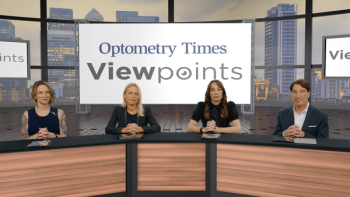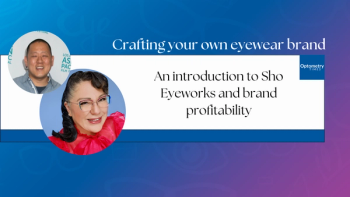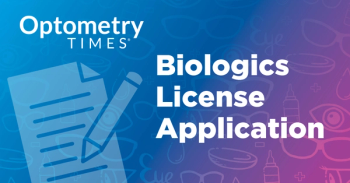
- July/August digital edition 2025
- Volume 17
- Issue 04
How can myopia be controlled when only a small percentage of doctors attempt to control it?
Specialty care is always needed in any field, and myopia control is no exception.
One would think that in the modern times in which we live, it shouldn’t take centuries to change treatment strategies for a condition such as myopia, but active control of myopia progression is a rarely practiced specialty. Myopia classically has been characterized as a refractive error, and its treatment has merely required refractive error compensation.
Myopia is on its way to affecting 5 billion people by the year 2050, with 1 billion of those achieving pathological levels,1 and there are undisputed correlations between each diopter (D) of myopia or each millimeter of axial elongation with vision-threatening diseases, such as glaucoma, cataracts, retinal tears, detachments, and myopic macular degeneration.2-4 As the leading cause of new blindness in places such as Shanghai and Japan,5 perhaps myopia or more specifically, excessive myopia progression will be considered a disease.
While there is no consensus among practitioners as to whether myopia is a disease, various industry organizations broadly agree that children with myopia and those identified to be at risk for myopia should be identified. Their parents should be educated on the risks of myopia progression and the several, quite effective treatments to delay the onset of and slow the progression of myopia.6 While it is certainly reasonable to argue that the existence of 1 or 2 D of myopia is not all that concerning, not all that debilitating and even useful in presbyopia, as many practitioners who do not treat myopia may argue, is there any reason to let your patients gradually and continually experience worse and worse vision, year after year?
I post a Marginally Interesting Cases of the Week to Myopia Profile on a decidedly nonweekly basis—when there is a marginally interesting case. With the appropriate apologies to Charles Dickens,7 this is a tale of 2 young myopes, including a rare one for me, one who continually refused any myopia treatment.
Figures 1 and 2 are images of a 16-year-old Chinese female adolescent, and she, and/or her parents, have refused any treatment beyond a large, semi-invisible, bifocal spectacle, which they variously either purchased from me, or went elsewhere and ordered single vision or progressive addition lenses. She has progressed in myopia by about –5.00 D in 7 years, along with marked increases in the area of peripapillary choroidal atrophy, accompanied by a development of white without pressure. No axial lengths were taken for this patient receiving standard-of-care myopia treatments, other than final measurements of 26.55 OD and 26.68 OS. Now, she would like to do orthokeratology, after the horse left the barn.
Figures 3 and 4 show images from 2016 and 2023 of a 21-year-old Chinese woman who has been in monthly center distance aspheric multifocals for the past 12 years with very stable vision and axial lengths. She remains in the multifocal, due to binocular vision issues (good ole eso fixation disparity at near)8 and her recent axial length changes are down to 0.04 mm per year over the past 7 years. She has progressed around –0.25 D total over those years as well. She has had a mild amount of peripapillary choroidal atrophy from the beginning and there has been no appreciable change observed over the past 7 years.
These cases can be an excellent way to argue for treating childhood myopia as they perfectly illustrate the “Tale of Two Myopes,” and I welcome anyone to use these images to help educate parents of the possible consequences of nontreatment.9
Standard-of-care model that reaches more children
Now that everyone is convinced that myopia progression deserves our best efforts, or at least our profession’s broad efforts to delay and slow its progression, it remains to be decided the best way to deliver this care to a greater proportion of the population. The treatments include encouraging outdoor activities, low-dose atropine eye drops,10 dual-focus contact lenses,11 extended depth-of-focus (EDOF) daily multifocals,12 other multifocal contact lenses prescribed off label,13 orthokeratology and perhaps one-day contact lenses in the US, myopia control spectacles such as those utilizing defocus-incorporated multiple segments technology, multiple aspherical lenslets, and contrast-reducing zones.14,15
What is frequently lost in the discussion about the standard-of-care and specialized tools is that we must lessen the global burden of myopia around the world. It simply would not be possible for the 5% of eye care practitioners (ECPs) who specialize in myopia control to take on the world. At the same time, it could border on malpractice if the rest of the ECPs do nothing differently than what they have done for hundreds of years. One simply needs to answer the question, “Which would reduce the global burden of myopia more effectively: if a small percentage of patients benefit greatly from specialty-level care and maximal efficacy treatments, or if the vast majority of children with myopia have its progression lowered by 30% to 40%?” The BLINK study (
An inspiring blend of 2 slogans, one a bit old, somewhat in line with the author’s age, “Everybody doesn’t like something, but nobody doesn’t like Sara Lee,” and a modification of the well-known Nike slogan, “Just Do It,” results in “Just Do Something.” That protocol could emerge for simple, effective myopia control by the nonspecialty practitioner. If every ECP just did something for myopia and chose a “Nobody doesn’t like Sara Lee”-type lens, their patients would benefit from significantly reduced myopia progression, at minimal additional cost, and with minimally increased chair time. Achieving a moderate level of myopia control, with a minimal to zero investment in specialty equipment, with fees still advantageous to the practice without being too much of a burden to the patient, is easy.
Of course, specialty care is always needed in any field, and myopia control is no exception. Some parents will have an interest in the most effective treatment, perhaps due to their own experience with myopia, or due to their concerns about their child’s worsening level of myopia, and they will seek expert care. Others may find that the milder forms of control that their general practitioner might offer may not be effective for their child, and they may be referred to a specialist, or seek a change on their own.
Suggested treatment protocol for the general practitioner
Once the decision has been made to help control myopia progression in a patient, an initial lens choice must be made. A general practitioner, inspired by the “Just Do Something” message, would be advised to prescribe multifocal contact lens, perhaps one with some evidence of success both in the control of myopia as well as in the subjective acceptance in children.13,16 With the appropriate stipulation that these cited lenses—a monthly center distance aspheric multifocal and a daily disposable EDOF aspheric multifocal—are not indicated for the control of myopia by the FDA, practitioners should keep in mind that the FDA doesn’t regulate the practice of medicine or optometry. So, doctors are free to use their discretion to utilize any product approved for other indications in the treatment of childhood myopia progression, particularly when those products have shown promise in various clinical trials. In the case of an astigmatism that requires correction, I encourage doctors to suppress their inner scientist that might say, “There are no studies to support the use of the toric version of the monthly distance center aspheric multifocal; therefore, one must not try to use it.” It’s almost too silly an argument to refute in the context of the clinical practice of myopia management. However, if you just can’t help yourself, you can always inform the patient that your choice of lens is based on the general scientific findings in the field and is worth a try. On the other hand, a recent study suggests that a commonly available daily disposable EDOF multifocal can provide good vision in the presence of relatively high levels of astigmatism, and that would be an alternative to a toric multifocal.17
These 2 types or categories of lenses could be used in the vast majority of young myopes in general practice. If the fees are in line with a multifocal contact lens fitting and the follow-up schedule aligns with a typical schedule for a soft lens fitting, and the practice doesn’t need to buy an optical biometer or a corneal topographer, the practice could find this treatment approach to be more profitable, more beneficial to the patients, yet still affordable for many patients.
Summary
To summarize, it is rapidly becoming the standard of care for eye care practitioners to identify patients with, or at risk of developing, myopia, to advise them of the possible future risks of visual impairment due to the myopia itself, but also the higher risks associated with axial elongation, and to provide appropriate treatments to manage their myopia or to refer them for such treatments. As only a small percentage of optometrists specialize in myopia control, it will prove impossible to meaningfully reduce the burden of myopia on society unless more practitioners commit to “Just Do Something.”
References:
Holden BA, Fricke TR, Wilson DA, et al. Global prevalence of myopia and high myopia and temporal trends from 2000 through 2050. Ophthalmology. 2016;123(5):1036-1042. doi:10.1016/j.ophtha.2016.01.006
Flitcroft DI. The complex interactions of retinal, optical and environmental factors in myopia aetiology. Prog Retin Eye Res. 2012;31(6):622-660. doi:10.1016/j.preteyeres.2012.06.004
Bullimore MA, Brennan NA. Myopia control: why each diopter matters. Optom Vis Sci. 2019;96(6):463-465. doi:10.1097/OPX.0000000000001367
Tideman JWL, Snabel MCC, Tedja MS, et al. Association of axial length with risk of uncorrectable visual impairment for Europeans with myopia. JAMA Ophthalmol. 2016;134(12):1355-1363. doi:10.1001/jamaophthalmol.2016.4009
Wu L, Sun X, Zhou X, Weng C. Causes and 3-year-incidence of blindness in Jing-An District, Shanghai, China 2001-2009. BMC Ophthalmol. 2011;11:10. doi:10.1186/1471-2415-11-10
Modjtahedi BS, Abbott RL, Fong DS, Lum F, Tan D;
Task Force on Myopia . Reducing the global burden of myopia by delaying the onset of myopia and reducing myopic progression in children: the Academy's task force on myopia. Ophthalmology. 2021;128(6):816-826. doi:10.1016/j.ophtha.2020.10.040Dickens C. A Tale of Two Cities. Masterpiece library edition. Peter Pauper Press; 2024.
Aller TA, Liu M, Wildsoet CF. Myopia control with bifocal contact lenses: a randomized clinical trial. Optom Vis Sci. 2016;93(4):344-352. doi:10.1097/OPX.0000000000000808
Aller T, Fricke T. Creating effective treatment protocols for myopia control. Review of Optometry. Published August 15, 2024. Accessed July 16, 2025.https://www.reviewofoptometry.com/article/creating-effective-treatment-protocols-for-myopia-control
Ha A, Kim SJ, Shim SR, Kim YK, Jung JH. Efficacy and safety of 8 atropine concentrations for myopia control in children: a network meta-analysis. Ophthalmology. 2022;129(3):322-333. doi:10.1016/j.ophtha.2021.10.016
Chamberlain P, Hammond DS, Arumugam B, Bradley A. Six-year cumulative treatment effect and treatment efficacy of a dual focus myopia control contact lens. Ophthalmic Physiol Opt. 2024;44(1):199-205. doi:10.1111/opo.13240
Cooper J, O'Connor B, Aller T, Dillehay SM, Weibel K, Benoit D. Reduction of myopic progression using a multifocal soft contact lens: a retrospective cohort study. Clin Ophthalmol. 2022;16:2145-2155. doi:10.2147/OPTH.S370041
Walline JJ, Walker MK, Mutti DO, et al;
BLINK Study Group . Effect of high add power, medium add power, or single-vision contact lenses on myopia progression in children: the BLINK randomized clinical trial. JAMA. 2020;324(6):571-580. doi:10.1001/jama.2020.10834Lembo A, Schiavetti I, Serafino M, Caputo R, Nucci P. Comparison of the performance of myopia control in European children and adolescents with defocus incorporated multiple segments (DIMS) and highly aspherical lenslets (HAL) spectacles. BMJ Paediatr Open. 2024;8(1):e003187. doi:10.1136/bmjpo-2024-003187
Rappon J, Chung C, Young G, et al. Control of myopia using diffusion optics spectacle lenses: 12-month results of a randomised controlled, efficacy and safety study (CYPRESS). Br J Ophthalmol. 2023;107(11):1709-1715. doi:10.1136/bjo-2021-321005
Aller T, Achenbach P, Cooper J, et al. Myopia management with naturalvue (etafilcon a) multifocal 1 day contact lenses: continuing evidence from clinical practice. Contact Lens Anterior Eye. 2019;42(suppl 1):E24. doi:10.1016/j.clae.2019.10.079
Carracedo G. Evaluation of visual acuity with multifocal catenary curve-based contact lens design in different degrees of astigmatism. Presented at: Global Specialty Lens Symposium; January 15-18, 2025; Las Vegas, NV.
Articles in this issue
4 months ago
Myopia is an escalating global health crisis4 months ago
Inside genetics and glaucoma5 months ago
Embracing dry eye5 months ago
A case of orthokeratology for high myopiaNewsletter
Want more insights like this? Subscribe to Optometry Times and get clinical pearls and practice tips delivered straight to your inbox.










































